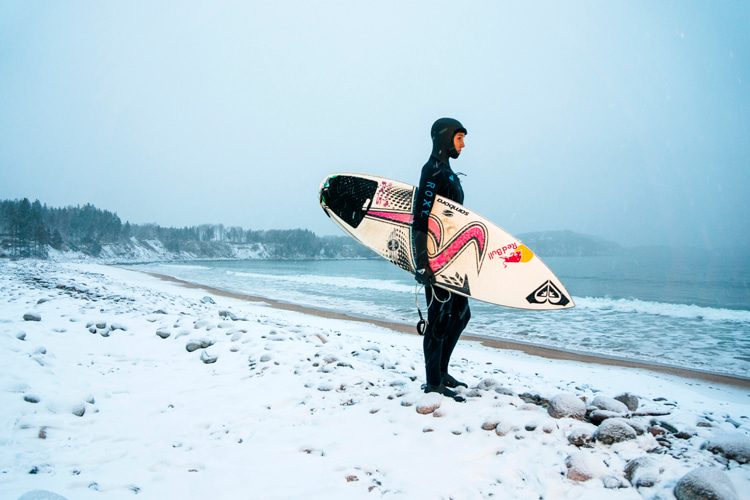20 tips to survive and enjoy cold water surfing

Cold water surfing is a physical and psychological test, even for the most passionate and hardcore surfers. Here are 20 tips to improve your experience in the chilliest conditions.
Low air and water temperatures can take a toll on the will to paddle out, but sometimes, the addition of surfing and good waves is too strong to resist.
Therefore, to truly enjoy it, preparation is key.
The cold can be tough on your body and soul, so having the right gear, habits, and mindset is essential to staying safe, warm, and stoked.
Let's get practical. Check out our comprehensive cold water surfing guide.
The following considerations work incrementally to minimize the roughness of surfing in cold waters.
1. Layer Up for the Surf Check
When checking the surf, it's easy to get chilled, especially in freezing conditions.
Dress in layers with a warm jacket, hat, and gloves to keep the cold at bay while you scout the waves.
Opt for windproof outerwear, as the wind can cut through regular jackets and rob your body of heat.
Having these layers ensures you don't start the session already cold.
Remember, keeping your core warm before hitting the water is crucial for lasting longer in low temps.
Spend a few extra minutes observing the waves, but prioritize staying warm.

2. Wear Clothes, Shoes, and Socks That Are Easy to Get On
Post-session, your body will be stiff and cold, so make sure to have clothes that are simple to slip into.
Loose-fitting sweatpants, a thick hoodie, and fleece-lined socks are lifesavers when your hands and feet don't cooperate.
Footwear is equally important. Slip-on boots or sneakers that don't require tying are perfect.
3. Suit Up at Home or in the Car
If you prefer to minimize exposure to the elements, put your wetsuit on before arriving at the beach or stay warm inside your car as you change.
This can be particularly helpful in windy or wet weather.
Use a portable seat cover or a towel to protect your car seats if you're suiting up inside.
4. Wear a Good Thick Winter Wetsuit
Invest in a high-quality winter wetsuit, ideally 5/4 mm or even 6/5 mm, to maintain warmth.
Seam technology makes a huge difference - choose glued and blind-stitched seams or liquid-sealed seams, which reduce water seepage.
A good wetsuit should fit snugly without restricting movement.
When choosing one, consider the flexibility of the neoprene or Yulex and ensure it matches the temperatures you'll dip in.
5. Wear a Neoprene Hood, Gloves, and Booties
Your extremities lose heat the fastest.
A thick neoprene hood (5 mm+), gloves (5 mm+), and booties (5 mm+) are essential for retaining body heat.
Look for items with a snug fit to avoid water flushing but not so tight that they hinder circulation.
These accessories shouldn't be optional in frigid water - they make the difference between an enjoyable session and one cut short by numbing cold.
6. Eat or Drink Something Hot on the Way to the Beach
Pre-session nutrition matters.
A hot drink like coffee, tea, or even broth not only warms your core but also gives you a psychological boost before stepping into icy water.
The idea is to make your brain want to paddle out.
If you're eating, go for something light and energy-packed, like oatmeal or a banana.
Avoid heavy meals, as digestion can draw heat away from your muscles.
7. Park Your Car So It Blocks the Wind
Strategically park your vehicle to shield yourself from the wind while changing.
The car acts as a natural barrier, creating a pocket of calm to suit up or dry off.
Wind magnifies the cold, so even small adjustments like using your car as a barrier can significantly improve your comfort.
8. Pile Your Clothes in the Order You'll Put Them On Afterward
After surfing, your body will cool down rapidly.
Arrange your clothes beforehand in the exact order you'll need them - underwear and socks on top, followed by warm layers.
The goal is to prevent fumbling around while shivering, and it ensures you don't accidentally leave something out in the rush to get warm.
9. Always Put on a Pair of Surf Earplugs
Cold water and wind can lead to surfer's ear, a painful condition caused by bony growths in the ear canal.
Surf earplugs help protect your ears while still allowing you to hear and stay balanced.
Make earplugs part of your gear routine. They're lightweight, affordable, and can save you from long-term hearing issues and expensive surgery.
10. Warm Up and Stretch
Before paddling out, warm up your muscles with a quick stretching routine.
Cold muscles are more prone to injury, and stretching increases blood flow, preparing your body for the session ahead.
Focus on your shoulders, back, and legs - key muscle groups for paddling and popping up.
Dynamic warm-up stretches like arm circles and lunges are especially effective.
11. Don't Go Out Alone
Cold-water surfing carries extra risks, from hypothermia to strong currents. Always bring a buddy who can assist in case of emergencies.
Not only is it safer, but surfing with a friend also makes the session more enjoyable and gives you someone to share the stoke with.
12. Choose the Right Wax for the Water Temperature
Cold water requires specially formulated wax that stays grippy in low temperatures.
Using the wrong wax can lead to slippery situations, making it harder to stay balanced on your board.
Check the wax label for the recommended temperature range and apply it generously to your board before heading out.
13. Delay the First Duck Dive to Avoid Brain Freeze
When paddling out, try to postpone the first duck. Let your body adjust to the cold water gradually.
Start with shallow dips to acclimate your face and head.
This simple trick can help prevent the shocking "brain freeze" sensation and make your entry into the surf more comfortable.
14. Paddle Around and Get Busy
Staying active keeps your body warm. Keep paddling between sets and avoid sitting idle in the lineup.
Movement generates heat and helps combat the chill.
Even small adjustments like fine-tuning the positioning in the lineup or warming up your arms can keep your blood flowing.
15. Resist the Initial Cold
It's normal to feel an initial chill, but your body often adjusts after a few minutes.
Fight the urge to leave too early; you might miss the best waves once you've warmed up.
16. Don't Push It Too Much
Listen to your body. Shivering, numb extremities, or feeling overly fatigued are warning signs of hypothermia.
Exit the water immediately and warm up if you experience these symptoms.
Safety always comes first. No wave is worth risking your health over, so set limits and stick to them.
17. Have a Heated Portable Shower in Your Vehicle
A warm rinse after surfing can make all the difference.
A heated portable shower is relatively inexpensive and a game-changer, washing away salt and restoring warmth to your body.
Set it up in advance so it's ready when you return. If a heated shower isn't an option, even a jug of warm water will do.
18. Have a Warm Drink in a Thermos
A thermos filled with hot tea, cocoa, or soup can quickly restore your core temperature after a session.
Sip it slowly to enjoy the warmth and keep your hands toasty.
Drinking something hot will not only be comforting but will help you recover from the cold you've been exposed to.
19. Use a Changing Pad and a Poncho
A waterproof changing mat protects your feet from the cold ground, while a surf poncho offers privacy and shields you from the wind.
These simple surf items make changing out of a wetsuit faster and more comfortable, especially in harsh conditions.
20. Dry Your Wetsuit for Your Next Session Completely
A damp wetsuit can be a frigid nightmare. Rinse your wetsuit with fresh water after each session and hang it to dry in a well-ventilated space.
Use a wetsuit hanger to speed up the drying process and avoid creases. Starting your next session in a dry suit makes all the difference.
Words by Luís MP | Founder of SurferToday.com
